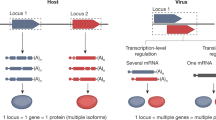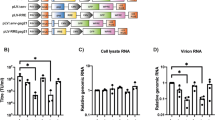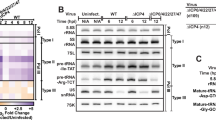Abstract
Amplicons are defective, helper-dependent herpes simplex virus type 1 (HSV-1)-based vectors able to convey more than 100 kbp of foreign DNA to the nucleus of mammalian cells. This unique feature make amplicons very appealing for preventive or therapeutic gene transfer requiring the transduction of very large pieces of DNA, as well as for upstream fundamental studies, such as functional genomics. Several recent achievements in amplicon technology have allowed to produce relatively large amounts of essentially helper-free amplicons, as well as to expand the host range of these vectors. In this review, we will update the current know-how concerning design, construction, and recent applications, as well as the potential and current limitations, of this interesting and promising class of vectors.
This is a preview of subscription content, access via your institution
Access options
Subscribe to this journal
Receive 12 print issues and online access
$259.00 per year
only $21.58 per issue
Buy this article
- Purchase on Springer Link
- Instant access to full article PDF
Prices may be subject to local taxes which are calculated during checkout


Similar content being viewed by others
References
Spaete RR, Frenkel N . The herpes simplex virus amplicon: a new eucaryotic defective-virus cloning-amplifying vector. Cell 1982; 30: 295–304.
Geller AI, Keyomarsi K, Bryan J, Pardee AB . An efficient deletion mutant packaging system for defective herpes simplex virus vectors; potential applications to human gene therapy and neuronal physiology. Proc Natl Acad Sci USA 1990; 87: 8950–8954.
Johnson PA et al. Cytotoxicity of a replication-defective mutant of herpes simplex virus type 1. J Virol 1992; 66: 2952–2965.
Fraefel C et al. Helper virus-free transfer of herpes simplex virus type 1 plasmid vectors into neural cells. J Virol 1996; 70: 7190–7197.
Saeki Y et al. Herpes simplex virus type 1 DNA amplified as bacterial artificial chromosomes in Escherichia coli: Rescue of replication-competent virus progeny and packaging of amplicon vectors. Hum Gene Ther 1998; 9: 2787–2794.
Saeki Y et al. Improved helper virus-free packaging system for HSV amplicon vectors using an ICP27-deleted, oversized HSV-1 DNA in bacterial artificial chromosome. Mol Ther 2001; 3: 591–601.
Zaupa C, Revol-Guyot V, Epstein AL . Improved packaging system for generation of high-level non-cytotoxic HSV-1 amplicon vectors using Cre-loxP site-specific recombination to delete the packaging signals of defective helper genomes. Hum Gene Ther 2003; 14: 1049–1063.
Logvinoff C, Epstein AL . Intracellular Cre-mediated deletion of the unique packaging signal carried by a herpes simplex virus type 1 recombinant and its relationship to the cleavage-packaging process. J Virol 2000; 74: 8402–8412.
Logvinoff C, Epstein AL . A novel approach for herpes simplex virus type 1 amplicon production, using the Cre-loxP recombination system to remove helper virus. Hum Gene Ther 2001; 12: 161–167.
Wade-Martins R et al. An infectious transfer and expression system for genomic DNA loci in human and mouse cells. Nat Biotech 2001; 19: 1067–1070.
Wade-Martins R, Saeki Y, Chiocca EA . Infectious delivery of a 135-kb LDLR genomic locus leads to regulated complementation of low-density lipoprotein receptor deficiency in human cells. Mol Ther 2003; 7: 604–612.
Inoue R et al. Infectious delivery of the 132 kb CDKN2A/CDKN2B genomic DNA region results in correctly spliced gene expression and growth suppression in glioma cells. Gene Therapy 2004; 11: 1195–1204.
Wang S, Voss J-MH . A hybrid herpesvirus infectious vector based on Epstein–Barr virus and herpes simplex virus type 1 for gene transfer into human cells in vitro and in vivo. J Virol 1996; 70: 8422–8430.
Kwong AD, Frenkel N . The herpes simplex virus amplicon. IV. Efficient expression of a chimeric chicken ovalbumin gene amplified within defective virus genomes. Virology 1985; 142: 421–425.
Geller AI, Breakefield XO . A defective HSV-1 vector expresses Escherichia coli beta-galactosidase in cultured peripheral neurons. Science 1988; 241: 1667–1669.
Tung C et al. Rapid production of interleukin-2-secreting tumor cells by herpes simplex virus-mediated gene transfer: implications for autologous vaccine production. Hum Gene Ther 1996; 18: 2217–2224.
During MJ, Naegele JR, O’Malley KL, Geller AI . Long-term behavioural recovery in parkinsonian rats by an HSV vector expressing tyrosine hydroxylase. Science 1994; 266: 1399–1403.
Rainov NG et al. A chimeric fusion protein of cytochrome CYP4B1 and green fluorescent protein for detection of pro-drug activating gene delivery and for gene therapy in malignant glioma. Adv Exp Med Biol 1998; 451: 393–403.
Shah K, Tang Y, Breakefield XO, Weissleder R . Real-time imaging of TRAIL-induced apoptosis of glioma tumors in vivo. Oncogene 2003; 22: 6865–6872.
Herrlinger U et al. Helper virus-free helper simplex virus type 1 amplicon vectors for granulocyte-macrophage colony-stimulating factor-enhanced vaccination therapy for experimental glioma. Hum Gene Ther 2000; 11: 1429–1438.
Federoff HJ, Geschwind MD, Geller AI, Kessler JA . Expression of nerve growth factor in vivo from a defective herpes simplex virus 1 vector prevents effects of axotomy on sympathetic ganglia. Proc Nat Acad Sci USA 1992; 89: 1636–1640.
Geschwind MD et al. Defective HSV-1 vector expressing BDNF in auditory ganglia elicits neurite outgrowth: model for treatment of neuron loss following cochlear degeneration. Hum Gene Ther 1996; 7: 173–180.
Linnik MD, Zahos P, Gescwind MD, Federoff HJ . Expression of bcl-2 from a defective herpes simplec virus-1 vector limits neuronal death in focal cerebral ischemia. Stroke 1995; 26: 1670–1675.
Lawrence MS, Ho DY, Steinberg GK, Sapolsky RM . Overexpression of Bcl-2 with herpes simplex virus vectors protects CNS neurons against neurological insults in vitro and in vivo.J Neurosci 1996; 16: 486–496.
Hoehn B et al. Overexpression of HSP72 after induction of experimental stroke protects neurons from ischemic damage. J Cereb Blood Flow Metab 2001; 21: 1303–1309.
Wang H et al. Over-expression of antioxidant enzymes protects cultured hippocampal and cortical neurons from necrotic insults. J Neurochem 2003; 87: 1527–1534.
Geller AI et al. An HSV-1 vector expressing tyrosine hydroxylase causes production and release of L-DOPA from cultured rat striatal cells. J Neurochem 1995; 64: 487–496.
Sun M et al. Correction of a rat model of Parkinson's disease by coepression of tyrosine hydroxylase and aromatic amino acid decarboxylase from a helper virus-free herpes simplex virus type 1 vector. Human Gene Ther 2003; 14: 415–424.
Brooks AI et al. Enhanced learning in mice parallels vector-mediated nerve growth factor expression in hippocampus. Hum Gene Ther 2000; 11: 2341–2352.
Neill JC et al. Enhanced auditory reversal learning by genetic activation of protein kinase C in small groups of rat hippocampal neurons. Brain Res Mol Brain Res 2001; 93: 127–136.
Adrover M et al. Hippocampal infection with HSV-1-derived vectors expressing a NMDAR1 antisense modifies behavior. Genes Brain Behav 2003; 2: 103–113.
Cheli VT et al. Gene transfer of NMDAR1 subunit sequences to the rat CNS using herpes simplex virus vectors interfered with habituation. Cell Mol Neurobiol 2002; 3: 303–314.
Wang Y et al. HSV-1 amplicon vectors are a highly efficient gene delivery system for skeletal muscle myoblasts and myotubes. Am J Physiol Cell Physiol 2000; 278: 619–626.
Wang Y et al. Herpes simplex virus type 1 amplicon vector-mediated gene transfer to muscle. Hum Gene Ther 2002; 13: 261–273.
Ferrera R et al. Efficient and non-toxic gene transfer to cardiomyocytes using novel generation amplicon vectors derived from HSV-1. JMCC 2004; 3: 219–223.
Muller L et al. Gene transfer into hepatocytes mediated by herpes simplex virus–Epstein–Barr virus hybrid amplicons. J Virol Methods 2005; 123: 65–72.
Willis RA et al. Dendritic cells transduced with HSV-1 amplicons expressing prostate-specific antigen generate antitumor immunity in mice. Hum Gene Ther 2001; 12: 1867–1879.
Savard N, Cosset F-L, Epstein AL . Use of defective HSV-1 vectors harbouring Gag, Pol and Env genes to induce the rescue of defective retroviral vectors. J Virol 1997; 71: 4111–4117.
Parrish E et al. Cell engineering for muscle gene therapy: extemporaneous production of retroviral vector packaging macrophages using defective herpes simplex virus type 1 vectors harbouring gag, pol, env genes. Cytotechnology 1999; 30: 173–180.
Sena-Esteves M et al. Single-step convesion of cells to retrovirus vector producers with herpes simplex virus–Epstein–Barr virus hybrid amplicons. J Virol 1999; 73: 10426–10439.
Hong Z et al. Enzymatic characterization of hepatitis C virus NS3/4A complexes expressed in mammalian cells by using the herpes simplex virus amplicon system. J Virol 1996; 70: 4261–4268.
Tsitoura R et al. Expression of hepatitis C virus envelope glycoproteins by herpes simplex virus-1 based amplicon vectors. J Gen Virol 2002; 83: 561–566.
Johnston KM et al. HSV-1/AAV hybrid amplicon vectors extend trransgene expression in human glioma cells. Hum Gene Ther 1997; 10: 359–370.
Hocknell PK et al. Expression of human immunodeficiency virus type1 gp120 from herpes simplex virus type 1-derived amplicons result in potent, specific, and durable cellular and humoral immune responses. J Virol 2002; 76: 5565–5580.
Samaniego LA, Neiderhiser L, DeLuca NA . Persistence and expression of the herpes simplex virus genome in the absence of immediate-early proteins. J Virol 1998; 72: 3307–3320.
Acknowledgements
AL Epstein acknowledges AFM (Association Française contre les Myopathies) and ARC (Association pour la Recherche sur le Cancer) for constant support to his laboratory.
Author information
Authors and Affiliations
Rights and permissions
About this article
Cite this article
Epstein, A. HSV-1-based amplicon vectors: design and applications. Gene Ther 12 (Suppl 1), S154–S158 (2005). https://doi.org/10.1038/sj.gt.3302617
Published:
Issue Date:
DOI: https://doi.org/10.1038/sj.gt.3302617
Keywords
This article is cited by
-
An HSV-1-H129 amplicon tracer system for rapid and efficient monosynaptic anterograde neural circuit tracing
Nature Communications (2022)
-
Intravesical treatment of advanced urothelial bladder cancers with oncolytic HSV-1 co-regulated by differentially expressed microRNAs
Gene Therapy (2016)
-
Using viral vectors as gene transfer tools (Cell Biology and Toxicology Special Issue: ETCS-UK 1 day meeting on genetic manipulation of cells)
Cell Biology and Toxicology (2010)
-
Cardiovascular gene therapy: current status and therapeutic potential
British Journal of Pharmacology (2007)



